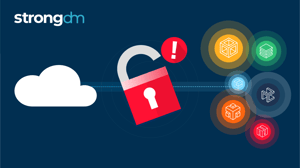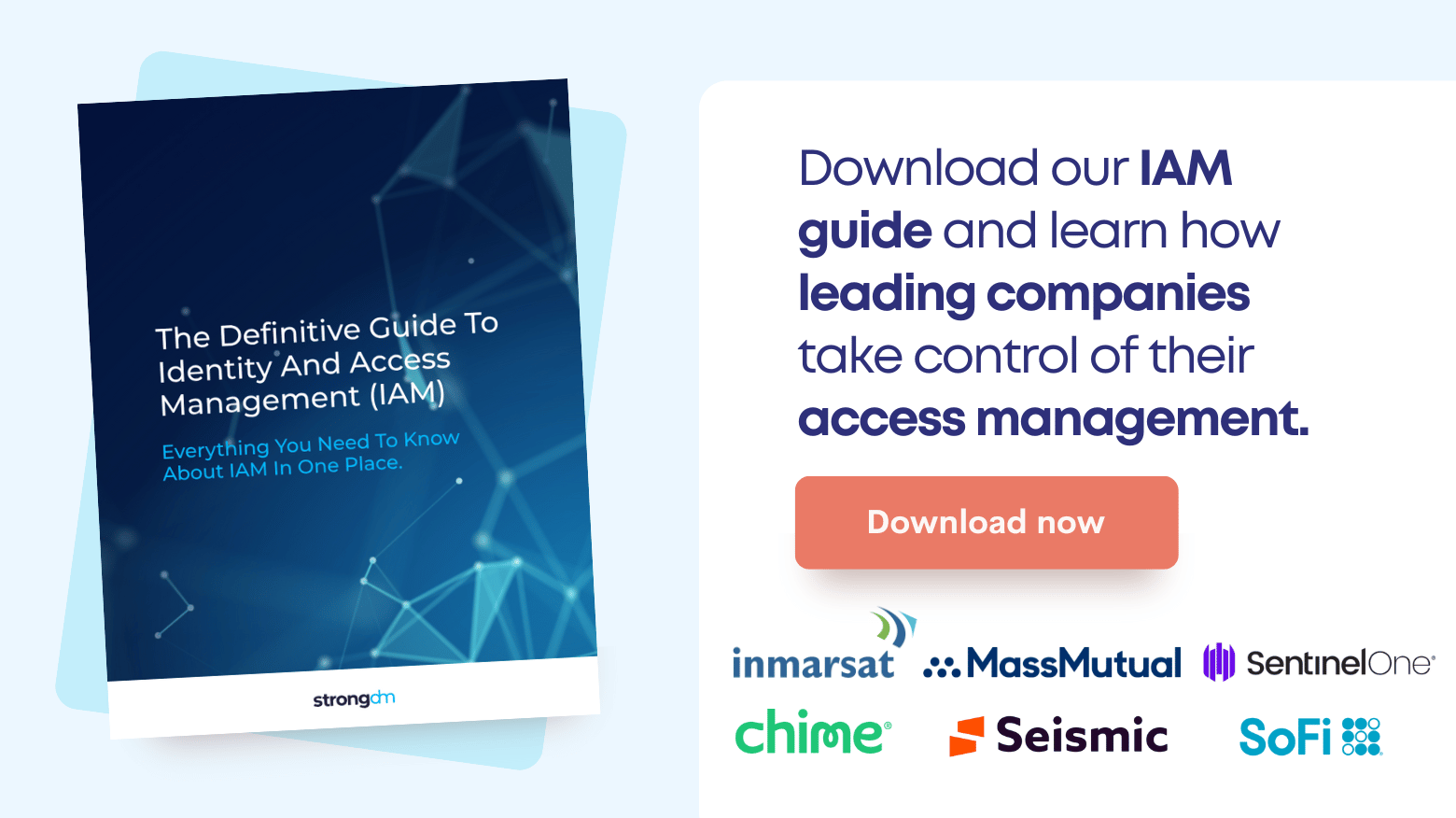Identity Access Management (IAM) vs. Privileged Access Management (PAM)


Written by
Maile McCarthyLast updated on:
October 17, 2025Reading time:
Contents
Built for Security. Loved by Devs.
- Free Trial — No Credit Card Needed
- Full Access to All Features
- Trusted by the Fortune 100, early startups, and everyone in between
Access management matters. These days, large-scale data breaches make news headlines more often than celebrity breakups, and 61% of those breaches involve credential data. That’s clearly a problem, and the search for a solution is likely to leave you in a sea of acronyms. PAM, IAM… what’s the difference? And what matters for your organization?
Today, we’re going to unravel some of those distinctions, with a closer look at the access challenges posed by multi-cloud environments and the way tools can help you bring access management under control.
Let’s start with some definitions.
IAM vs. PAM: What’s the Difference?
The concepts are closely related, but they are not the same. While both address the management of users, access, and roles, identity and access management (IAM) applies broadly to all users in your organization. IAM strategies dictate how to manage general access to resources such as devices, applications, network files, and environments. IAM eliminates shared accounts and requires that each user have a trusted digital identity (for example, a username and password) that must be managed and monitored throughout its lifecycle.
Privileged access management (PAM) is a subset of IAM focused on privileged users—those with the authority to make changes to a network, device, or application. Privileged users may include business users with elevated access requirements (such as employees in HR or finance), system administrators, application service accounts, and other high-level users. Privileged access management builds on the advantages of IAM. PAM establishes policies and practices to ensure the security of sensitive data and critical infrastructure and typically includes observability, automation, and fine-grained authentication and authorization.
As we’ll see, there is a large degree of overlap among PAM, IAM, and other related categories.
⚠️ Traditional PAM deployments have gaps. Learn how to protect your databases, the cloud, Kubernetes, and more with our legacy PAM augmentation guide.
IGA and PAM: Tracking User Access
One related system with a lot of overlap is Identity Governance and Administration (IGA). IGA provides the ability to monitor and audit access. This increases visibility and helps organizations meet compliance requirements such as SOX, SOC 2, and ISO 27001. Just as PAM does for privileged users, IGA tools help automate workflows for creating and managing accounts, roles, and access for all users.
IGA helps ensure that IAM protocols, including PAM, are connected and properly implemented. It helps improve the security of your organization, reduces identity-related risk, and streamlines the implementation of many PAM policies, particularly those related to auditing and compliance. In short, IAM grants access, IGA tracks it, and PAM does both (but specifically for privileged users).
Understanding these principles is an important first step toward securing your network. The next step is implementation.
IAM Misconfigurations in the Cloud
Modern computing environments present a host of new challenges for implementing access management policies. Access solutions must be flexible enough to handle:
- the introduction and adoption of new technology.
- the ephemeral nature of cloud infrastructure.
- the rapid scaling of enterprises and organizations.
On top of those complications, today’s workforce is increasingly remote/distributed and often uses their own devices. Throw third-party vendors and contractors into the mix, and manual methods like spreadsheets and checklists simply can’t keep up.
Cloud-managed access solutions such as AWS IAM answer many of these difficulties, but they’re not a panacea. Identity and access management misconfigurations may leave you with a false sense of security. And they open the door to security breaches, increasing the possibility that bad actors could gain access to company accounts and intellectual property. When it comes to cloud security, it is important to know what your cloud service provider (CSP) will or won’t do. Essentially, the cloud provider maintains the security of the cloud, while the customer maintains security in the cloud. Get to know the specifics of your CSP’s shared responsibility remodel as it applies to the services and applications you employ.
Once you understand the part you, as the customer, play in cloud security, you can watch out for configuration mistakes. Knowing what to look out for is an important first step in avoiding and correcting these errors. Here’s are some of the most common:
- Underutilized tools: A common “misconfiguration” is simply a failure to utilize the tools that are native to your cloud provider. All major cloud providers include settings to help you implement your PAM and IAM policies. These may include role-based access controls (RBAC), multi-factor authentication (MFA), and secrets managers. Don’t expect individual users to be security experts. Instead, use built-in tools to ensure that they follow the access policies you require.
- Misconfigured identities: Admins may set access controls to the most permissive settings as a way to ease friction, as overly restricted access can be cumbersome. While this may reduce administrative busywork for admins and ease workflow for users, too much access also opens the door to potential bad actors. An over-provisioned user can do a lot of damage, either intentionally or in error so be sure to follow the policies laid out in your IAM and PAM guidelines and implement your cloud-based identities following the principle of least privilege.
- Excessive access to storage: Ensure that your cloud storage is not publicly accessible or unrestricted as this could allow users to access and mishandle your data. They could delete it, copy it, encrypt it, or otherwise make it unusable. In cases where you know you want public access to storage, be sure to make access read-only. Keep track of where your data is and who needs access to it and encrypt/restrict access to only what is needed.
- Logging/monitoring not enabled: Utilize the logging capabilities of your cloud platform to maintain visibility into your network. Monitor all resources and assets when they are created, changed, or deleted, and keep a record of which identities are accessing your resources. And use native analytics tools like AWS CloudTrail, Azure Log Analytics, and GCP Cloud Audit Logs to detect inappropriate use patterns and unexpected activity. As noted earlier, monitoring increases visibility and supports compliance requirements so you can catch problems before they get out of control.
Correcting these common cloud configuration mistakes will help ensure that your data and infrastructure are protected.
In production environments that utilize more than one cloud platform (multi-cloud), administrators face an additional challenge, as they must understand the specific defaults, settings, and tools specific to each provider. Rather than attempt to stitch together a hodgepodge of security tools on their own, many teams are looking for a unified solution. In fact, Gartner identified the consolidation of security tools as one of the top security and risk management trends for 2021.
So how do you get unified access management?
Consolidated Access Management
While checklists and spreadsheets are important organizational tools, they aren’t enough to handle the complexity of modern cloud environments. And adding more technology to the mix may help you answer this or that problem, but it also creates new challenges as you struggle to integrate incompatible tools.
For an access management strategy to work, it must execute security policies without causing friction for your workforce. A unified access solution will allow you to grant and track access for both general and privileged users with:
- Role-based access control (RBAC). Restrict network access to authorized users based on their role within the organization, helping to enforce the principle of least privilege. This includes tools for enabling and disabling both privileged and standard business accounts and granting and revoking access rights for all users across devices, applications, and platforms.
- Automated provisioning. Replace tedious manual tasks with automated processes to remove administrative busywork for DevOps. Admins can grant access, including privileged access, in a time-bound manner. Automatically adding or removing access as roles change helps avoid privilege creep and improves policy adherence.
- Authentication. Single sign-on integration improves workflow by authenticating access to multiple accounts from a centralized entry point, while multi-factor authentication (MFA) adds a second layer of verification.
- Credential management. Automate the vaulting and rotation of passwords and other secrets to shorten the window of time in which they remain valid. This helps eliminate problems caused by lost, stolen, or shared passwords.
- Observability. Discover and prune “zombie” credentials that are currently unmanaged and maintain visibility into user access requests, approvals, and actions.
- Auditing tools. Log session reports, record and review access, and become aware of unusual activity. This makes it easier to meet compliance and regulatory requirements, particularly when applied to privileged access.
- Ease of use. Secure your infrastructure without disrupting workflow. After all, a tool is only effective if you can actually use it. A consolidated access management tool will simplify auditing for both general and privileged users, provide a single point of control for provisioning access, and streamline onboarding and offboarding for all users.
Simplify Access with StrongDM
We’ve seen how security breaches involving credentials present a major challenge for organizations, especially those operating in multi-cloud environments and managing remote access (namely, all of us). Infrastructure access policies, in particular, must be dynamic and flexible enough to secure access in an ever-changing setting—without causing friction to users, customers, or administrators.
StrongDM helps you manage access for all users, with auditing and observability, authentication, and networking built right into a single control plane.
Want to learn more? Sign up for our no BS demo and see for yourself.
Next Steps
StrongDM unifies access management across databases, servers, clusters, and more—for IT, security, and DevOps teams.
- Learn how StrongDM works
- Book a personalized demo
- Start your free StrongDM trial

Categories:

About the Author
Maile McCarthy, Contributing Writer and Illustrator, has a passion for helping people bring their ideas to life through web and book illustration, writing, and animation. In recent years, her work has focused on researching the context and differentiation of technical products and relaying that understanding through appealing and vibrant language and images. She holds a B.A. in Philosophy from the University of California, Berkeley. To contact Maile, visit her on LinkedIn.
You May Also Like





